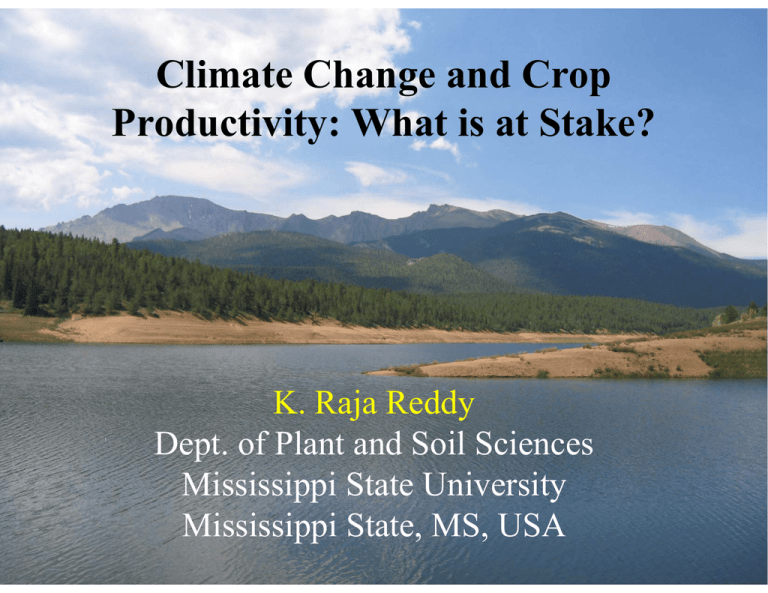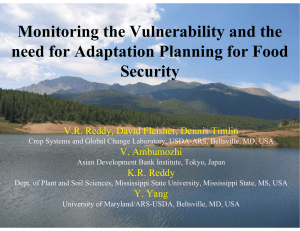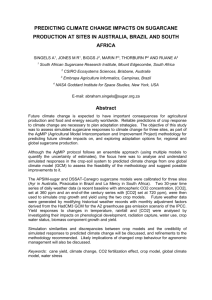Climate Change and Crop Productivity: What is at Stake? K. Raja Reddy
advertisement

Climate Change and Crop Productivity: What is at Stake? K. Raja Reddy Dept. of Plant and Soil Sciences Mississippi State University Mississippi State, MS, USA Outline | Past and future trends in population, food production and climate change perturbations. | Global environmental change and its impact on agriculture production systems. | Role of crop simulation models in addressing future food security and climate change. Trends That Shape Our Future Trends, Signs and Signatures from the Earth Past, Present and Future World Population 10 World Population Population in Billions 8 6 4 2 0 0 500 1000 Year 1500 2000 Trends, Signs and Signatures from the Earth Past, Present and Future World Population Trends 3000 Population, millions 2500 66% 9.4% 51% 2000 2050 127% 2,351 2000 1,803 1,531 1500 1,419 1,395 1,275 1,016 1000 -13% 48% 42% 796 728 768 631 520 500 448 315 0 Asia China Oceania (less China and India) India Africa North Europe Latin America America Trends, Signs and Signatures from the Earth Global Major Foods Production and Consumption Trends Production Consumption 10 450 2005, million Mt., % of the total Total = 270.3 400 Chicken Pig = 103 - 38% Chicken = 72 - 27% Cattle = 61 - 22% 350 6 Pig 4 Total Consumtion, lb/person Relative change, 1961=1 8 Vegetables = 3.21 lb/year Selected fruits = 1.95 lb/year 300 250 Meat and Poultry = 0.65 lb/year 200 2 Cattle 150 Flour and Cereals = 2.70 lb/year 0 1960 1970 1980 Year 1990 2000 2010 100 1965 1970 1975 1980 1985 Year 1990 1995 2000 Trends, Signs and Signatures from the Earth Maize: Production and Yield - Selected Countries P= 67%, and A= 46% Trends, Signs and Signatures from the Earth Rice: Production and Yield - Selected Countries 8 World 2004 average = 3.97 t ha-1 USA, 70 kg yr-1 Japan, 32 kg yr-1 7 China, 102 kg yr-1 Rice yield, t ha-1 6 5 Indonesia, 77 kg yr1 4 World, 53 kg yr1 3 India, 42 kg yr -1 Thailand, 21 kg yr-1 2 1 0 1960 1970 1980 Year 1990 2000 2010 Trends, Signs and Signatures from the Earth Management Practices on Soil Quality Fertility management Crop rotations 4 4.0 Sanborn Field: Central Missouri Morrow plots: East-central Illinois Soil organic carbon (%) Soil organic carbon (%) 3.5 3.0 2.5 2.0 2 1 1.5 1.0 Corn-oats-hay rotation Corn-oats (1885-1953), Corn-soybeans (1954-1988) Continuous corn Estimated to 4% in 1888 Wagner, (1989) 3 0 Wheat, 6 Tons Manure/year Corn, 6 Tons Manure/year Continuous Wheat Continuous Corn 1880 1880 1900 1920 1940 1960 1980 2000 Year Reicosky et al. 2000 1900 1920 1940 Year 1960 1980 Trends, Signs and Signatures from the Earth Cropland area, Irrigation and Salinization, and Management Practices on Soil Quality Cropland area Irrigated area Salinized area ----------------------------- Mha -------------------------------China 124.0 54.4 (22%) 7-8 (14%) India 161.8 54.8 (31%) 10-30 (50%) USA 177.0 22.4 (13%) 4.5 -6 (15%) USSR 204.1 19.9 (2%) 2.5-4.5 (21%) World 1364.2 271.7 (21%) 62-82 (37%) Percent change since 1985 S.G. Pritchard and J. S. Amthor, 2005 Trends, Signs and Signatures from the Earth Population, Cereal Yield, Arable and Irrigated Area, N Use Relative valuses (1961=1) 5 4 3 5 C ereal yield A rable land area Irrigated land area P opulation F ertilizer use 4 2000 v alues are: C ereal yield = 2.25 A rable area = 1.09 Irrigated area = 1.98 P opulation = 1.97 Fertilizer use = 4.33 3 2 2 1 1 0 0 1955 1960 1965 1970 1975 1980 1985 1990 1995 2000 2005 Year Feeding 10 Billion Mouths | We must develop the capacity to feed 10 billion people within the next 40 to 50 years. | The average world current cereal yield is about 3 tons per ha for about 6 billion people. | We need about 4 tons per ha for 8 billion (33 % more than the current), and 5 tons per ha for 10 billion (67 % more than the current). Routes to Greater Food Production | Increase in the area of land under cultivation. | Displacement of lower yielding crops by higher yielding ones (done since the dawn of domestication). | Efficiency of crop production in terms of: Per unit of land area (yield per ha) z Per unit of time z Per unit of inputs such as fertilizers, water and labor etc. z Here Comes the Greatest Challenge of our Time, The Global Climate Change Trends, Signs and Signatures from the Earth | | | | | | Greenhouse gases (CO2, CH4, N2O etc.) Temperatures Glaciers, oceans and sea-levels Precipitation patterns and drought intensities Extreme events Higher ozone and UV-B radiation Trends, Signs and Signatures from the Earth Global Carbon Emissions and Fluxes 10 8 350 6 325 4 300 2 275 Preindustrial -1850 = 0.005 billion Mt. Current, 2005 = 7.99 billion Mt. Difference = 7.93 billion Mt. 250 1700 1750 1800 Preindustrial -1850 = 501 Tg C Current, 2005 = 1467 Tg C Difference = 967 Tg 1850 Year 1900 1950 2000 Global carbon emission, billion Mt. C Preindustrial -1850 = 286 ppm Current, 2005 = 380 ppm Difference = 94 pmm 375 CO2 Concentration, ppm 5 12 4 3 2 1 0 0 Annual flux of carbon from land-use change, Pg C 400 Trends, Signs and Signatures from the Earth Past and Current Levels in GHG Concentrations, Rates of Change and Atmospheric Lifetime Global warming gases Ozone depleting chemicals Period CO2 Methane Nitrous oxide CFC-11 HFC-23 Perfluromethane Pre-industrial concentration (1850) about 280 ppm about 700 ppb about 270 ppb 0 0 40 ppt Current Concentration in 2008 386 ppm 1857 ppb 321 ppb 244 ppt 18 ppt 74 ppt Rate of change 1.43 ppm/yr 7.0 ppb/yr 0.8 ppb/yr -1.4 ppt/yr 0.55 ppt/yr 1 ppt/yr Atmospheric lifetime 5 to 200 years 12 years 114 years 45 years 260 Years >50,000 years Global Warming and the Ozone Story Global Warming Process Ozone Depleting Process CFCs are commonly used as refrigerants, solvents, and foam blowing agents. The most common CFCs are CFC-11, CFC12, CFC-113, CFC-114, and CFC-115. Trends, Signs and Signatures from the Earth Future trends in global carbon dioxide concentration and associated climate change, if no interventions are made Climate variable 2025 2050 2100 Carbon dioxide concentration 405-460 ppm 445-640 ppm 720-1020 ppm Global mean temperature change from the year 1990 0.4-1.1 oC 0.8-2.6 oC 2.4-6.4 oC Global mean sea-level rise from the year 1990 3-14 cm 5-32 cm 26-59 cm Climate Change and Crop Productivity Photosynthesis - Leaf Water Potential -2 Photosynthesis, mg CO2 m s -1 10 PPF, 1600 µmol m -2 s-1 700 µl l-1 CO 2 8 350 µl l-1 CO 2 6 4 2 0 -1.0 -1.5 -2.0 -2.5 -3.0 -3.5 -4.0 Midday Leaf Water Potential, MPa Well-watered Water stressed Climate Change and Crop Productivity Temperature and CO2 - Rice Yield 12 330 ppm 660 ppm Rice yield, t ha-1 10 8 6 4 2 Baker and Allen, 1993 0 20 22 24 26 28 30 Tem perature, °C 32 34 36 38 Baker and Allen, 2000 Climate Change and Crop Productivity Rice Growing Areas and Variety trial Experiments Growing season temperatures from those locations listed in the previous slide and with an additional 5°C added to those temperatures relative to optimum and marginal conditions 40 Temperature, °C 35 Ambient temperature: 25.36°C = 8.26 t/ha Ambient plus 5°C: 30.36°C = 5.51 t//ha, 33% 30 25 20 15 Sites Climate Change and Crop Productivity Temperature and Cotton Growth 4-week old cotton seedlings 20/12 25/17 30/22 35/27 40/32 °C Climate Change and Crop Productivity Temperature and CO2 - Cotton Reproductive Growth Fruit Production Efficiency (g kg-1 Dry Weight) 400 300 200 100 700 µL L -1 350 µL L -1 0 24 26 28 30 Temperature, °C 32 34 Reddy et al. 2002 Climate Change and Crop Productivity Temperature and CO2 – Rangeland C4 Grass: Big Bluestem Vegetative Weight and Seed Weight 50 5 Vegaetative 40 1.5% °C-1 4 30 3 20 2 10 0 15 Reproductive 8.4% °C-1 20 25 30 Temperature, °C 35 Seed weight, g plant-1 Vegaetative biomass, g plant-1 360 ppm 720 ppm 1 0 40 Kakani and Reddy, 2004 Climate Change and Crop Productivity Long-term Temperatures across Regions 40 Temperature, °C 35 Phoenix, AZ, USA Hyderabad, India 30 25 Maros Indonesia 20 15 10 5 Stoneville, MS, USA 0 0 50 100 150 200 250 Day of the Year 300 350 Issues of 21st Century, Particularly in Developing Countries | | | | Meeting food demands for the growing population. Reducing the risks of soil and ecosystem degradation. Minimizing the risks of eutrophication and contamination of natural waters. Developing scientific capacity and system tools to assess the impacts of climate change on food and fiber security. Can We Use Crop Models for Regional and Global Food and Fiber Security and Assist in Policy Decisions? • Simple models can’t simulate complex problems. • Robust and process-rich models are needed to study the impacts of climate change perturbation on agro-ecosystem goods and services. GOSSYM CLYMAT SOIL PIX PREP CHEM PNET GROWTH PMAP COTPLT ABSCISE PLTMAP FREQ DATES TMPSOL FERT FRTLIZ RAIN RUNOFF GRAFLO ET UPTAKE CAPFLO NITRIF RUTGRO RIMPED NITRO MATAL OUTPUT Liang et al. 2009 Crop Model Applications for Natural Resource Management 9 Farm management (e.g. planting, irrigation, fertilization and harvest scheduling). 9 Resource management (e.g. several Govt. agencies and private comp. use). 9 Climate change and policy analysis. 9 Production forecasts (e.g. global, regional and local forecasts). 9 Research and development (e.g. research priorities and guide fund allocations). 9 Turning information into knowledge (e.g. information overflow in every area including agricultural research). Crop Model Applications for Adaptation to Global Climate Change 9 What production strategies have the least risk of economic loss? 9 How can natural resource quality be best managed while achieving production goals? 9 What are the consequences of climate change on production, gaseous emissions, pest populations, etc.? 9 What would be the effect of regional drought on agricultural-based energy production? 9 What are the adaptation and mitigation approaches to agricultural production in 21st Century? Crop Model Applications for Climate Change Scenarios: A Case Study Potential as Well as Stress Interactions 2500 1600 Current CO2 effect Lint Yield (kg ha-1) Lint yield, lbs/acre 1500 1400 1300 2000 1500 500 1100 0 1980 2000 2020 2040 2060 Future 1980 1993 1989 1984 1000 1200 1960 1992 Current with elevated CO2 Hot/Dry Hot/Wet Cold/Dry Cold/Wet Normal Year Climate Change Scenarios Crop Model Applications for Climate Change Scenarios: A Case Study Planting date Adaptations 2500 Curent Future Yield, lb acre-1 2000 1500 1000 500 -30 -20 -10 0 10 Days from 1 May 20 30 Climate Change and Crop Productivity Some Considerations • Except limiting the causes of climate change, there are no other long-term strategies • For a shorter-term, we must develop crop varieties which can withstand changes projected in climate to meet the growing demands for food. - Cold, heat- and drought-tolerant varieties for temperate - Heat- and drought tolerant varieties for tropics • We must also develop models that provide adequate warning or guidance for policy makers to act proactively rather than reactively. • Everybody and every nation should participate in the process, and opportunities are there for everyone. We will be > 10 billion by 2050 in a much different climate than what we have today We need to produce enough goods and services in a sustainable way We need tools to provide information to policy makers Questions? “You can’t eat the potential yield, but need to raise the actual by combating the stresses” Norman E. Borlaug Nobel Peace Laureate “You can’t build peace on empty stomachs” John Boyd Orr Nobel Peace Laureate First FAO Director General



